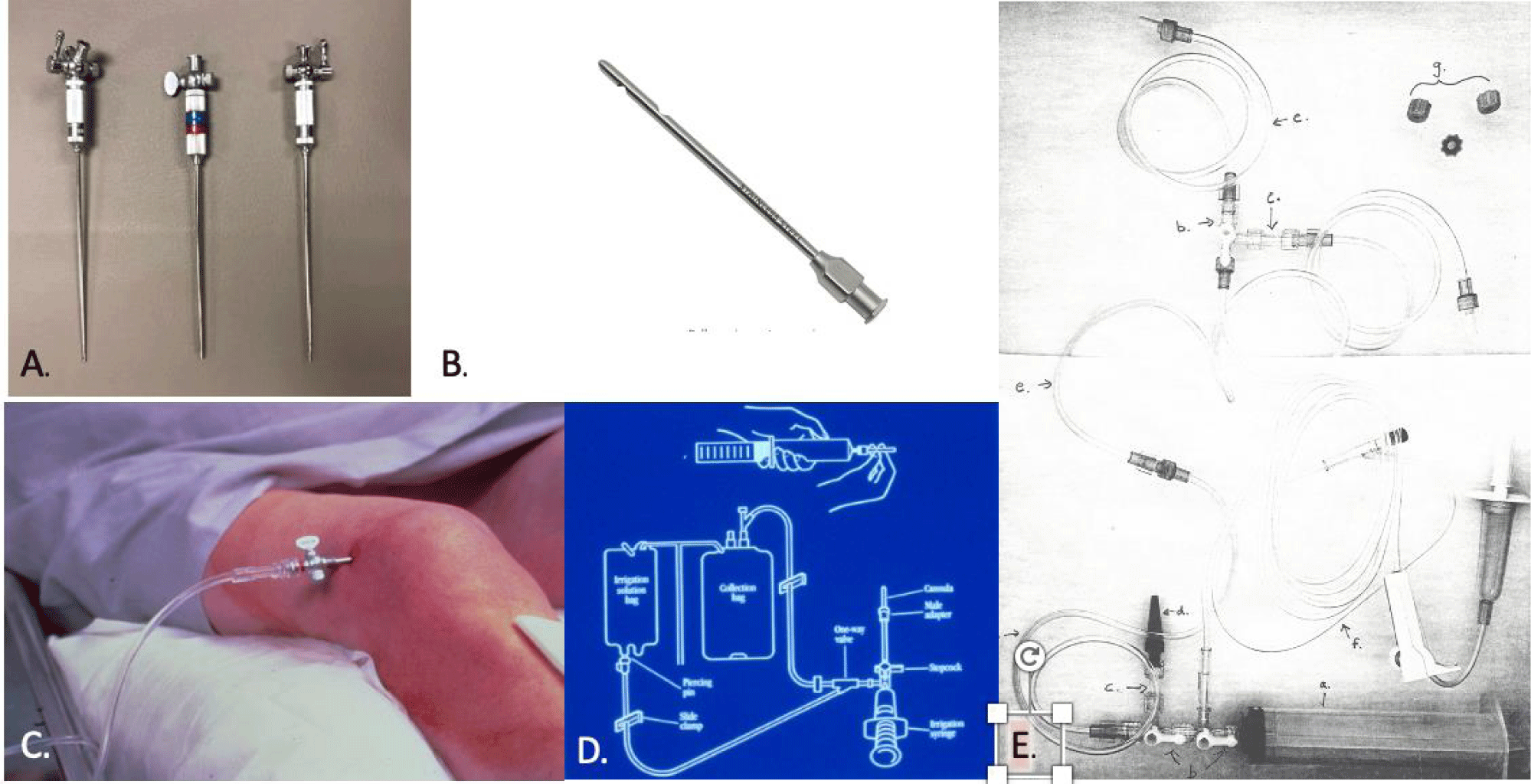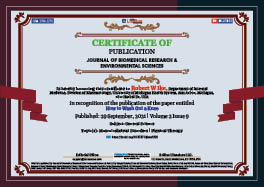> General Science. 2021 September 29;2(9):846-848. doi: 10.37871/jbres1320.
How to Wash Out a Knee
Robert W Ike
Observations that some patients with knee arthritis feel better after a simple diagnostic arthroscopy date to the earliest days of American orthopedists using the procedure [1]. While arthroscopy was not widely employed for another half century, washout of the knee through an arthrotomy was among the procedures applied to osteoarthritis in the pre-total joint arthroplasty era [2]. The father of modern arthroscopy – Watanabe – devised a technique “articular pumping” whereby a joint could be washed without employing an arthroscope by penetrating the knee with a large bore needle, instilling saline to distend the joint, then removing the fluid through the same needle, repeating the cycle until 1-2 liters had passed through [3]. He observed outcomes similar to what he had been seeing with arthroscopy. While the technique has never been widely practiced, it has been applied – under names such as “tidal irrigation”, “lavage”, and “washout” – to a number of clinical conditions involving the knee [4]. Most use has been in the most prevalent condition, knee osteoarthritis. A 2002 report of a trial comparing washout to sham injection in which no significant additional benefit accrued to the washed out dampened enthusiasm for the procedure [5], although the trial is suspect, as the “sham” injection of 0.25% bupivicaine has been shown to have effects well beyond the half-life of the drug [6]. Washout has the potential for “downstream” benefits, as microscopy of spent washout fluid can find evidence of internal derangements [7], and mesechymal stem cells have been isolated from washout fluid then used to repair cartilage defects in a rat model of OA [8]. A number of trials conducted over the last 2 decades support use of washout in OA, sometimes as a preface to another intraarticular treatment [9]. The phlogistic debris removed by washout in OA includes cartilaginous “wear particles” sloughed from the degenerating joint surface and known to perpetuate synovitis [10] while adversely affecting friction properties [11] and also calcium crystals, which are quite common by arthroscopic inspection [12] but usually not revealed by x-rays or synovial fluid analysis.
Other arthropathies approached with washout include the inflammatory arthropathies, crystal arthropathies, and septic arthritis. The “rice bodies” in the rheumatoid joint – coalescences of fibrin and sloughed synovial cells - can impede needle drainage and perpetuate inflammation [13]. Several trials have shown positive effects of washout, especially with larger volumes and followed by a glucocorticoid injection [14]. Researchers using arthroscopy to study and procure synovium state that an advantage of their approach over the less invasive and more popular ultrasound-guided biopsy is that the patients tend to feel better after the ‘scope, likely from the accompanying washout [15]. Adopters of arthroscopic surgery in the early 70s found the washout from arthroscopy to be effective against various crystal arthopathies [16]. Early, urgent, and thorough removal of joint purulence is now standard of care for septic arthritis [17]. However, an urgent trip to the O.R. for an arthroscopic washout is not always feasible. During the 2020 COVID-19 pandemic, British Orthopaedic Association (BOAST) guidelines dictated that medical treatment (closed-needle aspiration + antibiotic therapy) should be offered to patients as first-line management, and operative treatment (arthroscopic joint washout +/- synovectomy) be reserved for patients exhibiting signs of sepsis, reducing the exposure of infected patients to the O.R. environment [18]. In a small study done almost 30 years ago when standards for urgent surgical drainage were not as yet established, 11 patients managed medically were subjected to bedside washout at the point when surgical consultation would otherwise have ensued. 4/11 avoids surgery [19]. Such a simple bedside procedure could be utilized in scenarios where an arthroscopist is not available, especially in developing countries where all orthopedic services can be hard to come by [20].
Joint washout can be performed by anyone already proficient in arthrocentesis. Washout precedes much like arthrocentesis, needing additional equipment and time. A larger bore needle than the conventional 18-20 guauge is used in order to lessen resistance to flow and convey larger debris particles out of the joint. A 14 gauge Veress needle – of the sort used to induce pneumoperitoneum for laparoscopy – with its side holes and shut off valve, is ideal (Figures 1A, 1B). A needle introduced to me by a colleague at another Big 10 institution many years ago – the cow teat cannula – is well suited for joint washout. It too is 14 gauges and has side openings plus a luer hub. The tip is not sharp, and a 14 gauge needle with trochar must be used to make the initial penetration. The washout needles go in only after the joint has undergone a conventional arthocentesis through a well anesthetized entry site. After the synovial fluid is drained, through the same needle is instilled 30 ml 0.25% bupivacaine. The knee can then be penetrating with the washout needle and connected to the tubing that will carry washout fluid in to and out of the joint (Figure 1C) As a ready-made fluid management kit is not currently available (Figure 1D), a system must be assembled from regular stock i.v. supplies, including a macrodripper, several extension tubes, and 2 3-way stopcocks (Figure 1E). Washout can be followed by injection of glucocorticoid or hyaluronate, if desired. The entire procedure takes about a half hour. Equipment to automate the washout procedure, controlling pressures and flow rates, has been built and described [21]. However, published use has not extended beyond cadaver knees. The puncture site is closed with a Steri-Strip. Patients are immediately ambulatory, but must take caution because of the lingering effects of intra-articular anesthesia on knee proprioception and care to protect the healing puncture site. 3rd party payment for the procedure has been problematic in the U.S., utilizing a “miscellaneous knee procedure” CPT code and offering supporting documentation such as a procedure note and a copy of reference 9. Washout for knee OA remains popular in France, with nearly 300 washouts done last year at Hôpital Cochin in Paris [9].
In summary, bedside knee washout is a safe, simple, inexpensive procedure that can serve as an adjunct to the management of several different common arthritides that can affect the knee. Physicians who manage patients with these disorders would do well, by their patients and themselves, to learn how to do it.
References
- Burman MS. Arthroscopy or the direct visualization of joints: An experimental cadaver study. Clin Orthop Relat Res. 2001 Sep;(390):5-9. doi: 10.1097/00003086-200109000-00003. PMID: 11550876.
- Bastow J. Some orthopaedic procedures employed in the treatment of arthritis: (section of physical medicine). Proc R Soc Med. 1941 Dec;35(2):80-84. PMID: 19992449; PMCID: PMC1998273.
- Watanabe M. Articular pumping. J Jap Orthop Assoc. 1949;24:30-42.
- Ayral X, Dougados M. Joint lavage. Rev Rhum Engl Ed. 1995 Apr;62(4):281-287. PMID: 7606424.
- Bradley JD, Heilman DK, Katz BP, Gsell P, Wallick JE, Brandt KD. Tidal irrigation as treatment for knee osteoarthritis: a sham-controlled, randomized, double-blinded evaluation. Arthritis Rheum. 2002 Jan;46(1):100-8. doi: 10.1002/1529-0131(200201)46:1<100::aid-art10037>3.0.co;2-v. PMID: 11817581.
- Creamer P, Hunt M, Dieppe P. Pain mechanisms in osteoarthritis of the knee: Effect of intraarticular anesthetic. J Rheumatol. 1996 Jun;23(6):1031-1036. PMID: 8782136.
- Royle SG, Noble J, Parkinson RW, Freemont AJ. The diagnostic potential of synovial effusion in meniscal pathology. Arthroscopy. 1992;8(2):254-257. doi: 10.1016/0749-8063(92)90046-e. PMID: 1637442.
- Li J, Huang Y, Song J, Li X, Zhang X, Zhou Z, Chen D, Ma PX, Peng W, Wang W, Zhou G. Cartilage regeneration using arthroscopic flushing fluid-derived mesenchymal stem cells encapsulated in a one-step rapid cross-linked hydrogel. Acta Biomater. 2018 Oct 1;79:202-215. doi: 10.1016/j.actbio.2018.08.029. Epub 2018 Aug 28. PMID: 30165202; PMCID: PMC6510982.
- Ike RW, Kalunian KC, Arnold WJ. Why Not Wash Out the Osteoarthritic Knee? J Clin Rheumatol. 2021 Mar 1;27(2):43-45. doi: 10.1097/RHU.0000000000001672. PMID: 33298808.
- Estell EG, Silverstein AM, Stefani RM, Lee AJ, Murphy LA, Shah RP, Ateshian GA, Hung CT. Cartilage wear particles induce an inflammatory response similar to cytokines in human fibroblast-like synoviocytes. J Orthop Res. 2019 Sep;37(9):1979-1987. doi: 10.1002/jor.24340. Epub 2019 May 17. PMID: 31062877; PMCID: PMC6834361.
- Estell EG, Murphy LA, Gangi LR, Shah RP, Ateshian GA, Hung CT. Attachment of cartilage wear particles to the synovium negatively impacts friction properties. J Biomech. 2021 Aug 4;127:110668. doi: 10.1016/j.jbiomech.2021.110668. Epub ahead of print. PMID: 34399243.
- Ike R, Baskaran A, Chao J, Concoff AL, Wu CW, Sun B, Brion PH, Arnold EL, Klashman DJ, FitzGerald J, Kalunian KC. Prevalence of crystals in knee osteoarthritis: experience from patients undergoing arthroscopic procedures. J Clin Rheumatol. 2019 Jan;25(1):51-53. doi: 10.1097/RHU.0000000000000744. PMID: 29517555.
- Popert AJ, Scott DL, Wainwright AC, Walton KW, Williamson N, Chapman JH. Frequency of occurrence, mode of development, and significance or rice bodies in rheumatoid joints. Ann Rheum Dis. 1982;41(2):109-117. doi: 10.1136/ard.41.2.109.
- Ike RW. Arthroscopic lavage of the knee with or without corticosteroids versus joint aspiration-which is best? Nature Clin Pract Rheumatol. 2007;3(6):320-321. doi: 10.1038/ncprheum0499.
- Ike RW, Kalunian KC. Will rheumatologists ever pick up an arthroscope again? Int J Rheum Dis. 2021. https://doi: 10.1111/1756-185X.14184
- O’Connor RL. The arthroscope in the management of crystal-induced synovitis of the knee. J Bone Joint Surg Am. 1973 Oct;55(7):1443-9. PMID: 4758715.
- Elsissy JG, Liu JN, Wilton PJ, Nwachuku I, Gowd AK, Amin NH. Bacterial septic arthritis of the adult native knee joint. JBJS Reviews.2020;8(1):e0059-e0059. doi: 10.2106/JBJS.RVW.19.00059.
- Piper D, Smith G, Archer JE, Woffenden H, Bose D. Management of native joint septic arthritis, serial aspiration vs. arthroscopic washout during the COVID-19 pandemic. Cureus. 2020;12(11):e11391. doi: 10.7759/cureus.11391.
- Ike RW. Tidal irrigation in septic arthritis of the knee: a potential alternative to surgical drainage. J Rheumatol. 1993 Dec;20(12):2104-11. PMID: 8014939.
- Goldhaber, Nicole H. International comparative analysis to understand the capacity for arthroscopy training and practice in developing countries. Doctoral dissertation, Harvard Medical School. 2019.
- Ateschrang A, Albrecht D, Schröter S, Hirt B, Weise K, Dolderer JH. Septic arthritis of the knee: presentation of a novel irrigation-suction system tested in a cadaver study. BMC Musculoskelet Disord. 2011;12:180. doi: 10.1186/1471-2474-12-180.
- Ike RW, Arnold WJ, Rothschild EW, Shaw HL and the Tidal Irrigation Cooperating Group. Tidal irrigation versus conservative medical management in patients with osteoarthritis of the knee: A prospective randomized study. J Rheumatol. 1992;19:772‑779.
Content Alerts
SignUp to our
Content alerts.
 This work is licensed under a Creative Commons Attribution 4.0 International License.
This work is licensed under a Creative Commons Attribution 4.0 International License.









